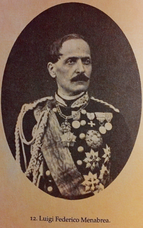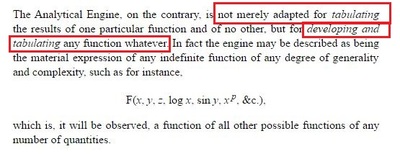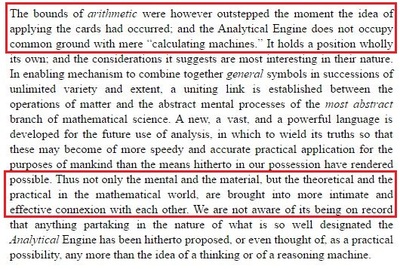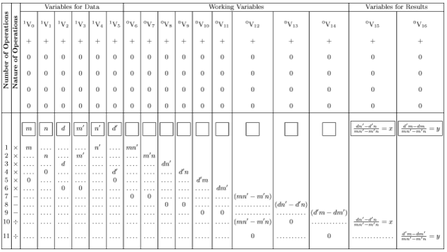Footnotes: The First Computer Program
|
In 1843, with Babbage's encouragement, Lovelace anonymously translated an article on the Analytical Engine by mathematician Luigi Federico Menabrea. Deciding to add her own work to the translated paper, Lovelace appended footnotes titled Notes and signed A.A.L. "The notes of the Countess of Lovelace [extended] to about three times the length of the original memoir [by Menabrea]. [Lovelace] entered fully into almost all the very difficult and abstract questions that connect with the subject," said Babbage [14]. "Her work, the explanation, of the computer and those notes that she wrote... far exceeded what Menabrea himself had done." -Mary Wade, author of Ada Byron Lovelace: The Lady and the Computer, Student phone interview [15]
|
|
While working with the Analytical Engine, Lovelace realized it could be limitlessly programmed. In her Notes, exploring territory no one had trekked before, Lovelace declared the Analytical Engine capable of functioning like today's general purpose computers.
|
"In Lovelace's Notes ... can be found the most interesting protoversions of many modern computing ideas-loops, if-then statements, the separation of hardware and software, and most radically, the concept of general-purpose computing: that is, the potential for the engine to go beyond the solving of numerical equations, and to manipulate any kind of information." -Sydney Padua, author of The Thrilling Adventures of Lovelace and Babbage [2] |
Click images to enlarge.
In addition to originating the idea of a general purpose computer in her Notes, Lovelace wrote the first step-by-step "computer" program, exploring the beginnings of computer science. This program could have catalyzed the Information Age in Europe a century earlier if not for the Analytical Engine's lack of funding.
|
Lovelace's Bernoulli's Numbers Program
"I want to put in something about Bernoulli's numbers, in one of my Notes, as an example of how an implicit function may be worked out by the engine, without having been worked out by human head and hands first. Give me the necessary data and formulae." -Ada Lovelace, letter to Babbage [8] This example of an "implicit function" was the first computer program in the world.
|
Click to zoom into explanation of operation card programs by Sydney Padua 2015 [2].
|
“While surely Babbage wrote small programs, all of his notes show very small, very unambitious programs, things that could have been done by any other mechanical [machine]... To me, it’s not ‘did you write any of these computer programs?’... It [is] did you understand that you could do anything with this computer, and did you write something that showed what the computer could do that no other machine in existence could do?’ And that’s exactly what [Lovelace] did. She said ‘What program [will] show that this is not just another mechanical computing machine? ' ” -Valerie Aurora, co-founder of the Ada Initiative, a non-profit organization, during student phone interview [9]
Symbiotic Relationship
|
Scroll over icons for description on drawing of the Analytical Engine
by Sydney Padua 2015. |
"You can think of Babbage as the person who did the hardware and Ada as the person who did the software. And you need both to have an effective computer so in that sense they're both the heroes of the story." |
Without the intellectual exchanges between Lovelace and Babbage, Lovelace's computer program would never have been created.






